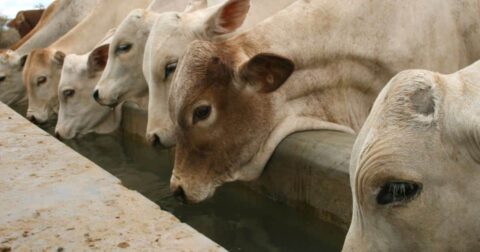News
Bird Flu Virus Might Resist Fever, Study in Mice Finds
Research•5 min read
Reported
In a new study, scientists found an antibiotic resistant gene lurking in the bacteria of cattle feedlot water bowls.


Words by Claire Hamlett
A new study adds to the science linking antimicrobial use in animal farming with the growing global health threat of antibiotic resistance. Scientists found the antibiotic resistant gene lurking in the bacteria of cattle feedlot water bowls.
Responsible for more than 1.2 million deaths worldwide, antibiotic resistance has many causes. But one leading driver is the way livestock and aquaculture operations use antibiotics.
Farms are misusing and overusing these drugs — both to promote speedier animal growth and to prevent diseases that spread easily in cramped and crowded factory farms. The problem only seems to be getting worse. According to analysis published last month in Nature, antibiotic use in farming is set to increase by 8 percent from 2020 to 2030.
In this latest study, scientists from the University of Saskatchewan analyzed bacteria in cattle feedlot water bowls, and were able to identify an antibiotic resistant gene capable of inactivating an entire class of drugs called macrolides. This category of medications includes treatments for tonsillitis in humans and bovine respiratory disease in cattle.
While the gene was already known, scientists weren’t aware of what it could do — render life-saving antimicrobials useless. The discovery is especially worrisome since the gene is already commonly found in the microbiome of many farm animals. It’s also found in pathogens known to cause bovine respiratory disease and a bacteria that infects poultry and pigs, according to the study.
Antibiotic resistant genes can spread far and wide on farms as they accumulate in the soil and the water. Dirt spreads from animal to animal, but it can also turn up on the shoe of a farm worker who in turn brings it home. Once enough resistant genetic material builds up in a human or an animal, antimicrobials are no longer effective to treat an infection in the body.
In other words, antibiotics are no effective at treating infections like bovine respiratory disease — which cattle are even more susceptible to when exposed to poor environmental conditions such as overcrowding or inadequate ventilation — causing more animals to suffer and die prematurely.
Funded in part by the Beef Cattle Research Council, the study authors recommend increased surveillance of antibiotic resistant genes to guide clinical practice — helping doctors figure out which drugs should be used for treatment. The researchers also argue for an improved system of analysis to identify more resistant genes based on how they pass between pathogens.
Researchers studying antibiotic resistance are already compiling information about these genes in databases like the National Database of Antibiotic Resistant Organisms. But these databases are incomplete, say the researchers. “Blind spots — novel and unreported ARGs — pose unknown risks to human health, animal wellness and the sustainability of agriculture.”
This particular resistant gene is not the only one that is known yet also not well studied. For this gene in particular, researchers were unaware of its resistance-potential — yet it had long been detected alongside other antibiotic resistant genes.
Public health experts agree that curbing antibiotic use on farms is an essential step for reducing antibiotic resistance worldwide. Yet despite the growing health threat, progress towards curbing agricultural use of antimicrobials has been extremely slow and modest.
A handful of countries have restricted or banned antibiotics to promote growth and to prevent disease. The U.K., for example, cut antimicrobial use in animals by 52 percent between 2014 and 2020. But globally, use of these drugs on industrial farming operations — both meat and aquaculture — only seems to keep going up.
In the U.S., where there is no system for tracking use of antibiotics on farms and efforts to reduce their use have been voluntary, sales of these medications for livestock are also again on the rise after a brief fall between 2015 and 2017.
It doesn’t help that in most places, there’s more demand for meat than ever. Consumption rates keep inching upwards, especially in the U.S., where the population already eats more than four times the global average for beef. One way to reduce antibiotic resistance is to adopt a plant-rich diet. Curbing demand for meat would help reduce not only antibiotic use rates but also the ever-accumulating resistant genes right along with it.